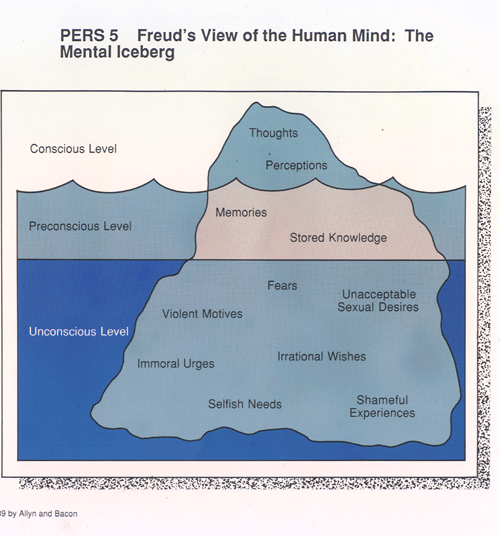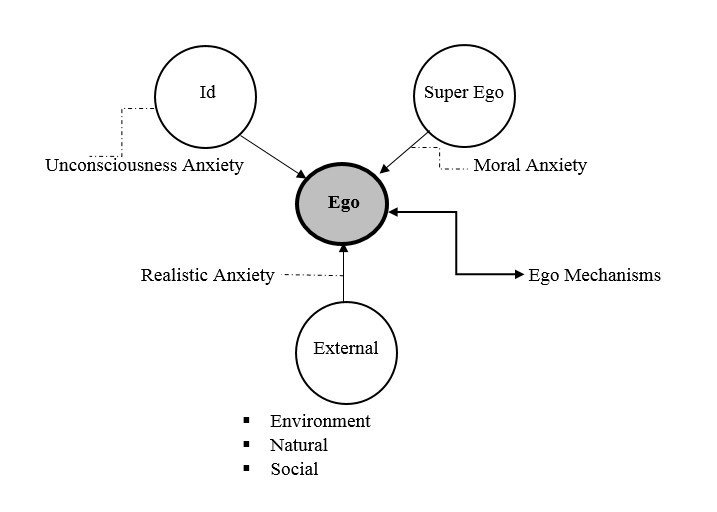
Analytical psychology is the most popular and historical subject in psychology, which is why this article was created. The main purpose of this article is to discuss the basic concept of analytical psychology and the basic levels and Instincts of the mind. In addition, what is the Defense Mechanism? Its fundamental differences, types and clinical aspect as well as the modern approach of Defense Mechanisms.
Introduction
Defense Mechanism is one of the main concepts of Sigmund Freud. It’s still a very popular concept in Psychology. Furthermore, it’s an unconscious and totally genuine psychological mechanism for reducing Anxiety that arises from three distinct aspects of the Mind. They are,
- When the “Id” impulses conflict with each other.
- When the “Id” impulses conflict with Super Ego’s values and beliefs.
- When an external threat is posed to the Ego.
The concept of these Id, Ego, and Super Ego comes from Sigmund Freud’s Structural model of Mind. Sigmund Freud likened it to the shape of an iceberg. In addition, it is also known as ice burg theory.
Topographical Structure of the Mind
Sigmund Freud’s topographical model represents his formation of the mind. According to Freud, there are three main levels of consciousness and three main components of the mind.
Levels of consciousness (Preliminary analysis)

- Conscious
- Pre-Conscious
- Unconscious
Components of mind (Later Analysis)

- Id
- Ego
- Super Ego
This Id, Ego, and Superego compose the three levels of awareness in the human mind. They are represented in following illustration below of the human mind.
Id
Humans are born with an Id. Freud refers to a newborn baby as a pill of Id. The Id is based on pleasure principle and it always tries to fulfill its instinctual impulses. In addition, it is a selfish, childish, pleasure-oriented part of the mind. Moreover, Id has not an ability to delay gratification. It represents the instinctual impulses in mind. What is more, it has two main instincts. There are,
- Life Instincts (Sex /Eross)
- Death Instincts (Aggression / Thanatos).
Ego
Ego is based on the reality principle and it understands that other people also have needs and desires. Therefore, Ego is always working as The Mediator of Mind. Moreover, it always tries to fulfill both Id’s and Super Ego’s needs and believes in a proper place, a proper time and in a proper way.
Super Ego
Super Ego is based on moral and cultural phenomena. Normally, the Super Ego begins at the age of five. Furthermore, Super Ego represents the Moral part of the mind. Therefore, it is developed with moral and ethical restraints placed on us by our parents. What is more, it depends on conscience with beliefs of right and wrong.
Structure of Ego Mechanism
The Ego has a difficult time satisfying both Id and Super Ego impulse. It doesn’t have the capacity to do this without help. Therefore, Ego uses tools and fulfill its job as the mediator. These tools help to defend the Ego. These are called as “Ego Defenses” or “Ego Defense Mechanisms”. When the Ego has a difficult time making both Id and the Super Ego Happy, it will employ one or more these defenses.
 Defense Mechanisms
Defense Mechanisms
Sigmund Freud was the first person to develop the concept of defense mechanisms as the part of his Psycho-Analytical Theory and further developed by his daughter, Anna Freud. Anna described different defenses in her first-born published book “Ego and Mechanisms of Defenses” in 1936. There are,
- Denial
- Displacement
- Projection
- Regression
- Repression
- Intellectualization
- Rationalization
- Sublimation
- Suppression
- Reaction Formation
Anna Freud spent significantly more time in research about this defenses more than her father spent his time. As the results, Anna Freud found five major mechanisms of defenses. These are,
- Repression
- Regression
- Projection
- Sublimation
- Reaction Formation
Repression
Repression involves a process of pulling thoughts into the Unconsciousness and preventing painful, frightening and dangerous thoughts from entering consciousness.
For example,
- Unconsciously blocking out, then forgetting sexual abuse from your childhood due to the trauma and anxiety.
Regression
Regression involves the reversion to earlier stages of development in the face of unacceptable impulses. When we are faced with Anxiety, we tend to retreat into our childhood. When we feel stress or Anxiety people very often can become more childish and more primitive. At the time even an adult may want to curl up in bed in a fetal position. Regression is an attempt to recapture some childhood satisfaction by relating to the world in a way that was formerly effective and giving up a mature problem-solving method to dealing with challenges.
For Example,
- Sitting in a corner and crying after hearing a bad news.
Projection
Projection involves to placing unacceptable impulses within you onto someone else.
For example,
- A passive aggressive person marries an overly angry person and both experience their disowned part in the other.
Reaction Formation
Reaction Formation involves to replacing anxiety or unacceptable emotions with their direct opposites. When we have a fear or too anxiety provoking, we unconsciously turn ourselves it the opposite side.
For example,
- One who is strongly attracted to pornography, but has moral or religious obligation to avoid it and might become its staunch critic.
Sublimation
Sublimation is the refocusing of psychic energy away from negative outlets to more positive outlets. In this way, people can use their emotions to fire up a cognitively oriented response.
For example,
- Becoming a boxer, Because of someone has an emotional state always going up and He is an aggressive person.
- Becoming a surgeon, Because of your desire to cut someone or like to see blood.
After the Era of Anna Freud, Other researchers and followers have added some more defense mechanisms to the common list of defenses. There are,
- Compensation
- Dissociation
- Fantasy
- Identification
- Undoing
- Withdrawal
Although, Defense Mechanisms are one of our most common ways to cope with unpleasant emotions. Freud and many of his followers believed that we use them to combat sexual or Aggressive feelings – these defenses apply to a wide range of reaction from Anxiety to insecurity.
The Classification of Defense Mechanisms and Its Clinical Aspect
Defense Mechanisms are the way of protecting our selves. When people are dealing with unconsciousness, the feeling desire is important – the defense mechanisms actually act as a psychological shield. It can help to reduce Anxiety or discomfort in the unconscious psychological process. Defense Mechanisms have several types and are divided clinically. Moreover, Different theorist has present different categorizations and conceptualization of Defense Mechanisms. Here are some of the many classifications of Defenses:
- Otto F. Kernberg’s Borderline Defense Mechanism.
- Robert Plutchik’s emotions based Defense Mechanism.
- George Eman Valliant’s Categorization of Defenses.
Otto F. Kernberg’s Borderline Defense Mechanism
The theory of borderline personality is developed by Otto F. Kernberg in 1967. His theory is based on Ego psychological object relation theory. Object relation theory is called an emotional bond between one person and another, as contrasted with an interest in and love for the self. What is more, it is usually described in terms of capacity for loving and reacting appropriately to others. Furthermore, an object relation is delayed or not achieved in borderline personality disorders. This personality organization develops when the child cannot integrate helpful and harmful mental object together. Kernberg views the use of primitive defenses as central to this personality organization. According to Kernberg, there have four primitive psychological defenses and they are called borderline defense mechanisms. There are,
- Projection
- Denial
- Dissociation
- Splitting
Robert Plutchik’s emotions based Defense Mechanism
Robert Plutchik developed a theory of defenses based on basic emotions. According to his theory, some defenses are related with emotions. There are,
- Reaction formation relates to joy (manic feature)
- Denial relates to acceptance (histrionic feature)
- Repression relates to fear (Passivity)
- Regression relates to Surprise (borderline traits)
- Compensation relates to sadness (depression)
- Projection relates to Disgust (paranoia)
- Displacement relates to Anger (hostility)
- Intellectualization relates to Anticipations (obsessionality)
George Eman Valliant’s Categorization of Defenses
The Psychiatrist George Valliant developed his theory in 1977 and this is the most famous modern categorization of Defenses. The diagnostic and statistical manual of Mental Disorders (DSM-IV) was published by the American Psychiatric Association (APA) in 1994 and it included a tentative diagnostic axis for defense mechanisms. This classification largely based on Valliant’s hierarchical view of defenses. Because in Valliant’s categorization relates to the psychoanalytical development level he has proposed but has some modifications. There are Denial, Fantasy, Rationalization, Regression, Isolation, Projection and Displacement.
Valliant introduced a four-level classification of Defenses. There are,
- Level I : Neurotic Defenses.
- Level II : Pathological / Psychotic Defenses.
- Level III : Immature Defenses.
- Level IV : Mature Defenses.
Basically, Mental Disorders are divided into two main categories in modern psychology. There is Anxiety Family (Simple Type) and Psychotic (Severe Type) Disorders. In category level one: “Neurotic Disorders” and category level two: “Psychotic Disorders”. These both terms are used to describe mental disorders or Mental illness and its effect on Mental Health. But, there have big differences between the two.
Neurotic Disorders can be any mental imbalance that causes distress. In general, neurotic conditions do not impair normal daily lifestyle or daily functioning. As an example, some people are afraid to speak in front of large crowds.
However, Neurosis or Neurotic is not severe as psychosis. Psychosis or Psychotic disorder is believed to be more of a symptom than a diagnosis. This type affects to human’s perception, thinking, thoughts, judgments, and behavior.
Neurotic disorders can handle through psychotherapy and counseling. On the other hand, psychotic disorders cannot be handled through non-drug therapies and counseling. Therefore, drug therapy is very important for psychotic disorders.
Neurotic Defenses
- Displacement – In this case, the psychological trauma that a person brings to another person. For example, someone with an underlying depression at a head office in a particular company is screaming at home at a family member, affecting a third party, such as disciplining a householder, and then releasing that stress.
- Reaction Formations – A person shows the opposite traits of his grief. For example, if someone loses a close friend, He or She smile rather than weeps. When a person becomes angry with someone, they talk about it rather than shouting at him or her.
- Intellectualization – In this context, instead of focusing on the sensitive emotional aspects of an event, it is possible to take seriously another kind of engagement. For example, let’s look at how to build a comprehensive outline plan for how you can manage yourself alone in the future to absorb the intense stress levels caused by your decision to leave the boardroom for a long time while being in the one place you least want to be, Here, he or she fails to escape.
- Rationalization – Formulating a rational basis for dealing the psychological trauma using justification, reasoning, and excusing. As an example, the behavior of the spouse who left his or she spouse because of his or her sexual impotence.
- Regression – The mind moves into a stage that is mentally and happily emotional, in order to get rid of the embarrassment. Often, this is where the mindset is absorbed by moving thought to a previous mental state or moment, which is often different from the current mental psyche. When a young person is in a state of emotional shock, he or she can take the time with toys or the fingers on their hand.
- Repression – This is a process the Ego uses to avoid the unpleasant thoughts in the mind. The mind identifies and hides the unpleasant emotions that were experienced. Because of this, happiness can be maintained for some time without any bitterness. This is the first and most important security update discovered by Sigmund Freud. In this case, the psychological shock of the unpleasant experience will be temporarily removed. But this is not a long-term successful method. There may be anxiety during this time in spite of the repression.
Psychotic Defenses
- Projection – placing unacceptable impulses in yourself onto someone else. When someone has this defense they experience delusions about internal reality.
- Denial – The heart refuses to hear shocking news or stories. The person in denial doesn’t accept what is being seen or heard. For example, When a loss of money is discovered, the person’s view is that it is cannot be true. The idea that smoking is dangerous and life threating is ignored.
Immature Defenses
These Defenses are often seen in major depression and personality disorders. They include,
- Projection – In this regard, an unpleasant feeling is substituted for another thought. For example, a person is hating his father, but he does not accept what is in his own mind and heart and absorbs the trauma caused by this mental state, and believes that his father hates him. Often, it is the result of a weakness or problem of other, not one’s own.
- Passive Aggressive Behavior – an indirect expression of hostility.
- Hypochondriasis – An excessive worry about having a serious illness.
Mature Defenses
These are commonly found among emotionally healthy Adults. They have been adapted through the year in order to optimize success in human society and relationships. The use of Defenses enhances pleasure and feelings of control. In addition, these defenses help to integrate conflicting emotions and thoughts. Mature Defenses include,
- Sublimations – Here is how to change human mind or emotions. In this case, an event triggers a person’s shock or feeling of pressure to take positive, productive action. For instance, an emotional upheaval can lead to a desire for physical exercise. The emotional stress of his primarily due to shock absorption, such as playing the guitar and body growth.
- Humor – An overt expression of ideas and feelings that gives pleasure to others.
- Suppression – Transfer negative thoughts into the back of mind so productivity can occur until the time comes when the suppressed thoughts and feelings can be dealt with.
- Altruism – constructive service to others that brings pleasure and personal satisfaction.
- Anticipation – Realistic planning for handling and/or eliminating future discomfort.
According to the above facts, Defense Mechanisms is helpful and healthy if used in a proper manner. If misused or misunderstood, the same defense mechanisms may also be unhealthy.
Sigmund Freud also saw defenses as necessary, But, He considered most of them negative, the only positive one being ‘sublimation’. Many researchers continued with this view and they also believed that most of the defenses involve lies. Therefore, the main problem with defense Mechanisms is that if they are used for a long time they may become automatic and separate a person from their true feelings and from reality.
Conclusion
Defense Mechanisms are neither good nor bad in themselves. It all depends on how, and for how long, they are being used. These are often needed and used to protect one’s self from pain. However, usually this is a temporary solution and they cross the very thin line between the healthy and unhealthy use of this psychological ‘painkiller’ like a patient becoming addicted to medical painkillers used to treat physical pain. Therefore, people shouldn’t use defense Mechanisms after they’re no longer necessary for them to use.
References
- American Psychiatric Association. 1994, Diagnostic and statistical manual of mental disorders (4th ed.). Washington, DC: Author.
- Datta, Mausumi, Three levels of conscious by Sigmund Freud, Available From https://mausumidutta.wordpress.com/2015/02/03/three-levels-of-consciousness-by-sigmund-freud-conscious-preconscious-unconscious/. [20 August 2017].
- Defense Mechanisms, Available from https://en.wikipedia.org/wiki/Defence_mechanisms. [21 June 2017].
- Freud: History and Concept, Available from http://freudhistoryandconcepts.blogspot.com/2008/04/3-levels-of-awareness.html. [23 August 2017]
- Gupta, Seema. Sharma, H. Kumar 2009, Psychology in Psychotherapy, Lotus Publications, Jalandhar, India.
- Grohol, John M. 15 Common Defense Mechanisms, Available from https://psychcentral.com/lib/15-common-defense-mechanisms/. [29 September 2017].
- Kendra, Cherry. 2015, Defense Mechanisms. Available from http://psychology.about.com/od/theoriesofpersonality/ss/defensemech.htm. [06 December 2017].
- Kernberg, O 1967, Borderline personality organization, J Am Psychoanal Assoc. 15 (3): 641–85. PMID 4861171. doi:10.1177/000306516701500309.
- Plutchik, R., Kellerman, H., & Conte, H. R. 1979, A structural theory of ego defenses and emotions. In C. E. Izard (Ed.), Emotions in personality and psychopathology New York: Plenum Press.
- Roy F. Baumeister, Karen Dale, Kristin L. Sommer 1998, Freudian Defense Mechanisms and Empirical Findings in Modern Social Psychology: Reaction Formation, Projection, Displacement, Undoing, Isolation, Sublimation, and Denial, Journal of Personality, 66: 1081–1124. doi:10.1111/1467-6494.00043, Available of http://onlinelibrary.wiley.com/doi/10.1111/1467-6494.00043/abstract. [26 August 2017].
- Saul, McLeod. 2008, Defense Mechanisms, Available from http://www.simplypsychology.org/defense-mechanisms.html. [12 December 2017].
- Susan, Krauss. Whit, Bourne 2011, The Essential Guide to Defense Mechanisms, Available from https://www.psychologytoday.com/blog/fulfillment-any-age/201110/the-essential-guide-defense-mechanisms. [14 December 2017].
- Vaillant, George E. 1977, Adaptation to life. Boston: Little, Brown. ISBN 0-316-89520-2.





